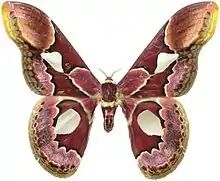Rothschildia erycina
Rothschildia erycina, or Rothschild's silk moth, is a moth of the family Saturniidae first described by George Shaw in 1796. It is found from Mexico to Brazil and Paraguay. The habitat is tropical rainforest and wet savannah. It is found on altitudes of up to 1,200 meters above sea level.
| Rothschildia erycina | |
|---|---|
 | |
| Male | |
 | |
| Male | |
| Scientific classification | |
| Kingdom: | Animalia |
| Phylum: | Arthropoda |
| Class: | Insecta |
| Order: | Lepidoptera |
| Family: | Saturniidae |
| Genus: | Rothschildia |
| Species: | R. erycina |
| Binomial name | |
| Rothschildia erycina (Shaw, 1796) | |
| Synonyms | |
| |

Male from Loreto, Peru
The larvae feed on Ailanthus altissima, Coutarea, Exostema, Ligustrum, Antonia, Cenostigma, Chiococca and Dodonaea species. The larval stage lasts about 40 days. Pupation takes place in a large silken cocoon. The pupal stage lasts 3 to 4 weeks.
Subspecies
- Rothschildia erycina erycina
- Rothschildia erycina mexicana Draudt, 1929 (Mexico)
- Rothschildia erycina nigrescens Rothschild, 1907 (Costa Rica to Ecuador)
This article is issued from Wikipedia. The text is licensed under Creative Commons - Attribution - Sharealike. Additional terms may apply for the media files.